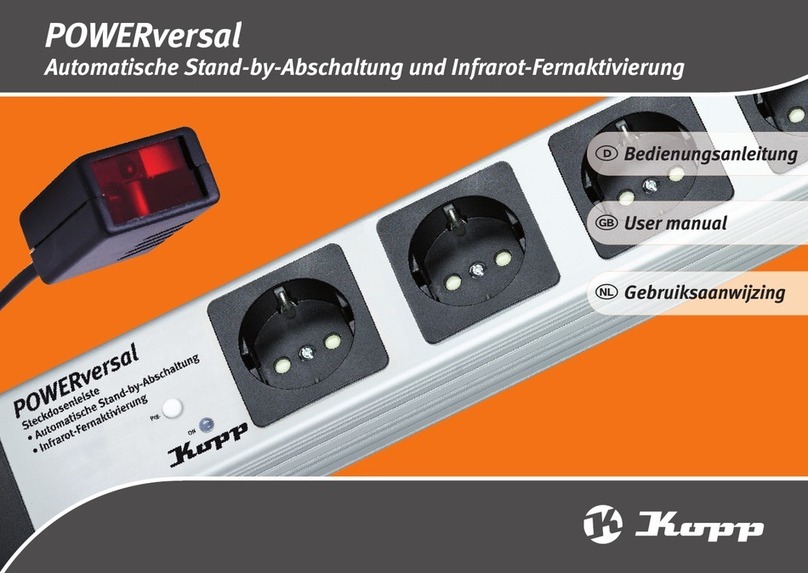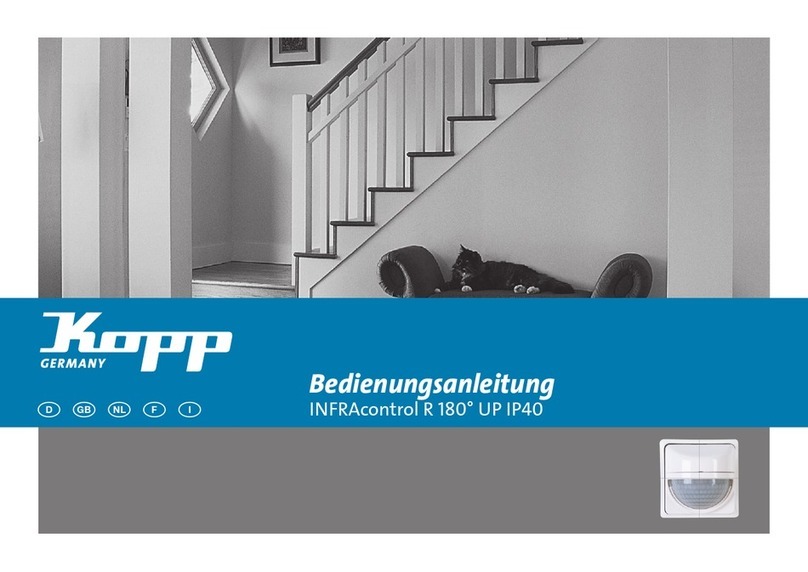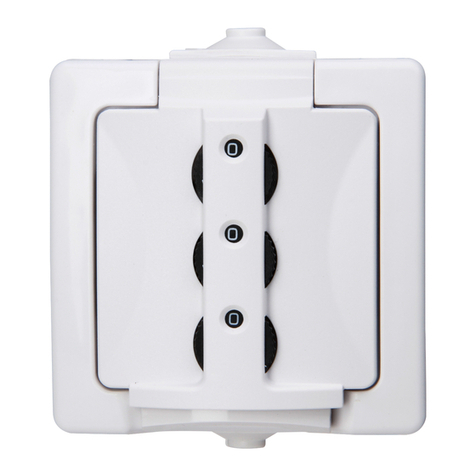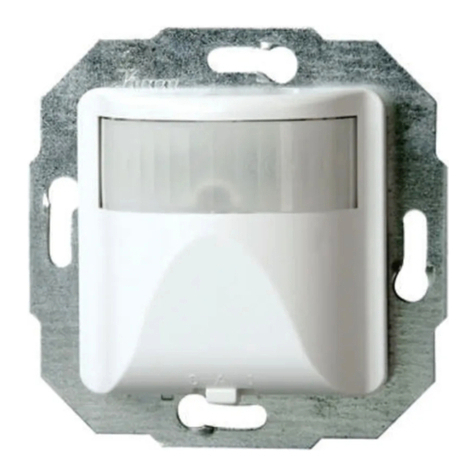Kopp 2931.1302.9 User manual

Bedienungsanleitung (2-4)
Instruction Manual (5-8)
Bedieningshandleiding (9-12)
Mode d‘emploi (13-16)
Istruzioni sull‘uso (17-20)
Instrucciones de manejo (21-24)
Funk Magnetsensor
Radio magnetic sensor
Radio-magneetsensor
Capteur magnétique radio
Radiosensore magnetico
Radiosensor magnético
Artikel-Nr. 2931.1302.9
Stand Juni 2008 - ID-Nr.: 058 609 010
Heinrich Kopp GmbH
Alzenauer Str. 68
63796 Kahl
www.heinrich-kopp.de
www.free-control.com
(25-26)
�

2
Bedienungsanleitung bitte sorgfältig durchlesen!
Eine zuverlässige Frühwarnung und Schutz vor
Einbruch ist nur gegeben, wenn dieser Funk Magnet-
sensor in Einklang mit den folgenden Anweisungen
verwendet wird.
Anwendung
Überwachung von Türen und Fenstern. Erkennt das
Öffnen oder Schließen von Türen und Fenstern.
Überwachung von Gegenständen gegen unberech-
tigtes Entfernen.
Montage
Geeigneten Montageort wählen. Bohrschablone vor-
handen. Kunststoffunterteil für Höhenausgleich .
Vor endgültiger Montage bitte prüfen, ob der vorge-
sehene Empfänger das Funksignal des Magnetkon-
takts sicher empfängt. Gegebenenfalls Position des
Empfängers oder des Magnetsensors ändern.
Mitte des Magneten muss mit der Pfeilposition auf dem
Gehäuse des Funk Magnetsensors übereinstimmen .
Hinweis: Nicht auf oder in der Nähe von Metall-
flächen (z.B. Scharniere, Beschläge, Rahmen)
montieren.
Spannungsversorgung
3 V Lithiumbatterie CR 2450.
Batterielebensdauer bis zu 2,5 Jahre.
LED blinkt 1x beim Einlegen der Batterie .
Richtige Batteriepolung beachten.
Batteriekapazität wird überwacht.
Empfehlung: Batterietausch alle 2 Jahre
Sabotagekontakt
Zum einwandfreien Betrieb Gehäusedeckel richtig
aufsetzen = Sabotagekontakt geschlossen.
Beim Sabotageversuch wird Sabotagemeldung
gesendet.
Externer Kontakt
Zusätzlicher Kontakt ist anschließbar .
Dies kann ein zusätzlicher potentialfreier Magnet-
kontakt, Reedkontakt oder anderer Kontakt sein.
Elektronik erkennt zusätzlichen Kontakt automatisch,
nachdem dieser einmal geschlossen wurde.
Funk Magnetsensor und externer Kontakt arbeiten
gleichwertig / parallel.
Ohne externen Kontakt:
Anschlussklemmen können offen bleiben .
Drahtbrücke nicht notwendig .
Betriebsanzeige
LED blinkt 1x beim Einlegen der Batterie und
geht dann aus:
• Batterie voll
• Gerät betriebsbereit
LED blitzt 1x pro Minute:
• Batterie schwach
• Alarmerkennung noch möglich
• Signalaussendung noch möglich
LED blinkt schnell:
• Batterie fast leer
• Alarmerkennung nicht mehr möglich
• Signalaussendung nicht mehr möglich
Die Konformitätserklärung kann unter folgender Adresse gefunden werden:
Heinrich Kopp GmbH • Alzenauer Straße 68 • 63796 Kahl am Main oder www.free-control.com

3
Funktionseinstellung
Funk Magnetsensor ist ausschließlich Sender.
Es können beliebig viele Empfänger im Sendebe-
reich auf den Schaltbefehl angelernt werden.
Kombination mit anderen Free-control Geräten
Steckbrücke für die folgenden Anwendungen auf
Position stecken:
• Signalauswertung durch die Funk Alarmstation
• Schalten von Funk Empfängern
- UP Empfänger 1Kanal 2 Draht und 3Draht
- UP Empfänger 2Kanal oder Rollladen
- UP Empfänger Taster oder Zeitfunktion
- UP Empfänger Dimmfunktion für elektronische
Trafos (Ein/Ausschaltfunktion)
- UP Empfänger Dimmfunktion für herkömmliche
Trafos (Ein/Ausschaltfunktion)
- Lampenfassung
- Adapter Schaltfunktion
- Adapter Dimmfunktion (Ein/Ausschaltfunktion)
- Schutzkontakt-Steckdosenleiste
Sabotagekontakt ist hierbei nicht aktiv.
Steckbrücke für die folgenden Anwendung auf
Position stecken:
• Signalauswertung durch die Einbruchalarmzentrale
• Signalauswertung durch die PC-Software für
Einbruchalarmzentrale
Sabotagekontakt und Magnetsensor werden hierbei
permanent überwacht.
Anlernen an Funk Empfänger und/oder Funk Alarmstation
Steckbrücke einstellen . Lernmodus des Empfängers
aktivieren (separate Bedienungsanleitung beachten).
Das Schaltverhalten des Magnetsensors für den
Betriebsfall auswählen. Dazu die PROG Taste unter-
schiedlich lange drücken.
Betriebsfall 1:
Senden des Signals „EIN-Schaltbefehl“ beim Schließen
einer Tür oder eines Fensters.
Senden des Signals „AUS-Schaltbefehl“ beim Öffnen
einer Tür oder eines Fensters.
Betriebsfall 1 einstellen:
PROG Taste < 1 Sekunde drücken, LED leuchtet
für 3 Sekunden.
Magnetsensor sendet zwei Signale.
Erst EIN dann AUS Signal innerhalb von 2 Sekunden.
Empfänger LED muss 2x blinken.
Anlernvorgang wird automatisch beendet.
Betriebsfall 2:
Senden des Signals „EIN-Schaltbefehl“ beim Öffnen
einer Tür oder eines Fensters.
Senden des Signals „AUS-Schaltbefehl“ beim Schlie-
ßen einer Tür oder eines Fensters.
Betriebsfall 2 einstellen:
PROG Taste > 2 Sekunden drücken
LED blinkt kurz
Magnetsensor sendet zwei Signale:
Erst AUS dann EIN Signal innerhalb von 2 Sekunden
Empfänger LED muss 2x blinken.
Anlernvorgang wird automatisch beendet.
Anlernen an Funk Einbruchalarmzentrale und/oder
PC-Software für Einbruchalarmzentrale
Steckbrücke einstellen .
Lernmodus der Funk Einbruchalarmzentrale, PC-Soft-

4
ware für Einbruchalarmzentrale aktivieren (separate
Bedienungsanleitung beachten).
PROG Taste drücken.
LED leuchtet ca. 3 Sekunden.
Anlernvorgang wird automatisch beendet.
Achtung: Zwischen zwei Signalaussendungen muss
der Magnetkontakt mindestens 2 Minuten geschlos-
sen gewesen sein.
Nach jedem Öffnen des Magnetkontaktes wird ein
Funksignal gesendet. Anschließend wird die Erken-
nung für ca. 2 Minuten gesperrt. Der Magnetkontakt
muss für die nächste Signalaussendung wieder für ca.
2 Minuten geschlossen sein. Wird innerhalb dieser
Sperrzeit von ca. 2 Minuten erneut ein Öffnen des
Kontaktes erkannt, wird kein Funksignal gesendet Die
Sperrzeit von ca. 2 Minuten beginnt jedoch erneut.
Falls Programmierung nicht erfolgreich war:
Hinweise in Rubrik Fehlersuche (FAQ) unter
www.free-control.com beachten.
Statusmeldung
Statusmeldung wird ca. alle 4 Stunden gesendet.
Überwacht wird:
• Batteriekapazität • Magnetkontakt intern
• Sabotagekontakt • externer Kontakt
Hinweise
Mit Free-control schalten Sie einfach, komfortabel
und bequem Ihre Elektrogeräte. Ein funktionsfähiges
Funksystem besteht in der Minimalausführung immer
aus einem Funk-Sender und einem Funk-Empfänger. Bei
Free-control (mit Logo: ) können alle Sender mit allen
Empfängern verknüpft werden, Ausnahme für Geräte mit
folgenden Artikelnummern xxxx.xxx1.x (mit Logo: ).
Haftungen oder weitergehende andere Ansprüche,
insbesondere solche auf Ersatz außerhalb des
Gerätes entstehender Personen- oder Sachschäden,
durch keine oder fehlerhafte Funktionen sind ausge-
schlossen.
Alle Sendecodes sind werkseitig eingestellt und
können nicht verändert werden.
Die Funkübertragung erfolgt auf einem nicht exklusiv
verfügbaren Frequenzkanal mit 868 MHz. Störungen
sind daher nicht auszuschließen.
Die Funkreichweite ist abhängig von Sendeleistung,
Störeinflüssen und baulichen Gegebenheiten.
Die Empfangssicherheit nimmt mit zunehmenden
Abstand zwischen Sendern und Empfängern ab. In
Gebäuden ist die Reichweite abhängig von den dort
eingesetzten Baumaterialien.
Material Typische Reichweite
Mauerwerk 20m - max. durch 3 Wände
Stahlbeton 10m - max. durch 1 Wand/Decke
Gipskarton/Holz 30m - max. durch 5 Wände
Free-control Funktechnik ist nicht geeignet für Si-
cherheitsanwendungen, z.B. NOT-AUS, NOT-RUF.
Beachten Sie die Regeln der Elektrotechnik und die
technischen Daten!
Führen Sie keine Änderungen an den Geräten durch.
Änderungen aufgrund technischen Fortschritts, Nor-
menänderungen, veränderter Fertigungsverfahren
oder Konstruktionsänderungen bleiben ausdrücklich
vorbehalten.
Für den Betrieb in EU, EFTA-Mitgliedsstaaten zugelassen.
Weitere Informationen, Anwendungsbeispiele,
Sortimentsübersicht, Bedienungsanleitungen in je-
weiliger Landessprache unter www.free-control.com

5
Please read the operating instructions carefully!
Dependable early warning and protection against
burglary is only ensured if this radio magnetic
sensor is used in accordance with the following
instructions.
Application
Monitoring of doors and windows. Detects the ope-
ning or closing of doors and windows.
Monitoring of objects to prevent unauthorized
removal.
Mounting
Select a suitable mounting location. Drilling guide
exists. Plastic base for height adjustment .
Before final mounting, please check to ensure that
the intended receiver reliably receives the radio sig-
nal of the magnetic contact. If necessary, change the
position of the receiver or the magnetic sensor.
The center of the magnet must match the arrow posi-
tion on the housing of the radio magnetic sensor .
Note: Do not mount on or near metal surfaces (e.g.
hinges, fittings, frames).
Power supply
3 V lithium battery CR 2450.
Battery life up to 2.5 years.
LED blinks 1x when the battery is inserted .
Ensure correct battery polarity.
Battery capacity is monitored.
Recommendation: Replace battery every 2 years
Sabotage contact
For proper operation, install the housing lid correctly
= sabotage contact closed. A sabotage message is
transmitted in case of attempted sabotage.
External contact
A second monitoring loop in the form of an additi-
onal contact can be connected . This can be
an additional magnetic contact, reed contact or
other contact. Electronics automatically detect the
additional contact after this has been closed. Radio
magnetic sensor and external contact work synchro-
nously/parallel.
Without external contact:
Terminals can remain open.
Wire jumper not necessary .
Status display
LED blinks 1x when the battery is inserted and
then goes out:
• Battery full
• Device ready for operation
LED flashes 1x per minute:
• Battery weak
• Alarm recognition still possible
• Signal broadcast still possible
LED blinks quickly:
• Battery almost empty
• Alarm recognition no longer possible
• Signal broadcast no longer possible
Table of contents
Languages:
Other Kopp Accessories manuals






















